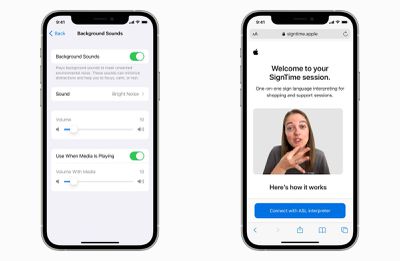Apple today announced the upcoming launch of several new accessibility features that are being added to its various products and services. Apple says that these options are designed for people with mobility, vision, hearing, and cognitive disabilities, and showcase Apple's belief that accessibility is a human right.

"At Apple, we've long felt that the world's best technology should respond to everyone's needs, and our teams work relentlessly to build accessibility into everything we make," said Sarah Herrlinger, Apple's senior director of Global Accessibility Policy and Initiatives. "With these new features, we're pushing the boundaries of innovation with next-generation technologies that bring the fun and function of Apple technology to even more people -- and we can't wait to share them with our users."
There are new features for communicating with support staff, operating the iPad, navigating the Apple Watch, and more, with a rundown below.
- Background Sounds - In support of neurodiversity, Apple is adding a Background Sounds feature that's designed to minimize distractions to help users stay focus, stay calm, or rest. Balanced, bright, or dark noise sounds are available, as well as ocean, rain, or stream sounds. All of the sounds can be set to play in the background to mask unwanted environmental or external noise. Apple says the sounds mix into or duck under other audio and system sounds.
- AssistiveTouch - For users with limited mobility, AssistiveTouch will allow the Apple Watch to be used without the need to touch the display or the controls. Built-in motion sensors, the optical heart rate sensor, and on-device machine learning will let Apple Watch detect subtle differences in muscle movement and tendon activity that will control a cursor on the screen through hand gestures like a pinch or a clench. AssistiveTouch launches later this year.
- iPad Eye-Tracking - Later this year, iPadOS will support third-party eye-tracking devices to let people control iPad with their eyes.
- SignTime - SignTime will allow customers to communicate with AppleCare and retail customer care using American Sign Language in the United States, British Sign Language (BSL) in the UK, or French Sign Language (LSF) in France using a web browser. SignTime launches May 20.
- New Memoji Customizations - New memojis are coming to better represent users with oxygen tubes, cochlear implants, and a soft helmet for headwear.
- VoiceOver Improvements - Recent updates to VoiceOver let users explore more details about people, text, table data, and other objects within images. VoiceOver can describe a person's position along with other objects in images, and with Markup, users can add image descriptions to personalize their photos.
- MFi Hearing Aid Improvements - Apple is introducing new support for bi-directional hearing aids, enabling hands-free phone and FaceTime conversations. Next-generation models from MFi partners are coming later this year.
- Audiograms for Headphone Accommodations - Headphone Accommodations will gain support for audiograms, so users can customize their audio by importing their latest hearing test results.
- Sound Actions for Switch Control - This replaces physical buttons and switches with mouth sounds -- such as a click, pop, or "ee" sound -- for users who are non-speaking and have limited mobility.
- Display and Text Size Settings - Will be customizable on a per app basis for users with colorblindness or other vision challenges to make the screen easier to see.
Apple is announcing these new features in celebration of Global Accessibility Awareness Day, which takes place May 20. Apple is also celebrating through new additions to Apple Fitness+, Today at Apple, the App Store, the Apple TV app, and more.
Many of these new features are slated for release later in the year, which suggests that they'll be included in the iOS 15 update that Apple is set to introduce at the Worldwide Developers Conference.
Apple's full announcement has more detail on just what's coming and when, and it's well worth checking out.
























